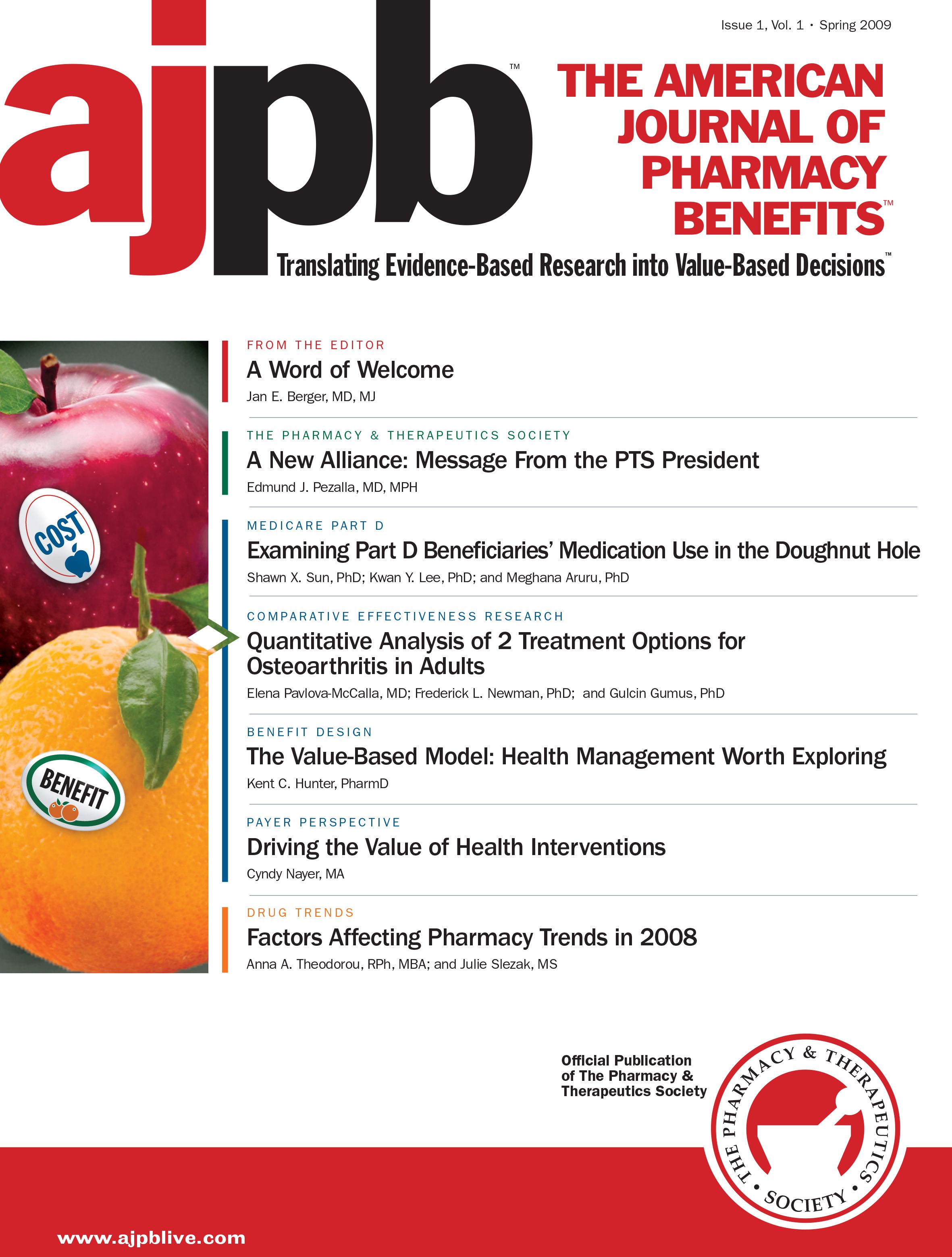Publication
Article
AJPB® Translating Evidence-Based Research Into Value-Based Decisions®
Driving the Value of Health Interventions: An Update on Value-Based Innovation
Author(s):
The President & CEO of the Center for Health Value Innovation uses the Hunter article as a springboard to call us to action�to share our successes, to learn from our mistakes, and to use the data available to develop value-based systems within our own organizations.
Fueled by the promise of total healthcare reform, many buzzwords are circulating in the healthcare domain today, including value-based benefit design, value-based insurance design, value-based purchasing, and value-based [insert the word you know best]. In this issue, Hunter provides an overview of 3 iconic stories of value-based benefit design, namely, Pitney Bowes, the Asheville Project, and the University of Michigan.1 Together, they provide the impetus and business-based evidence to propel other companies, particularly self-insured enterprises, to take the leap into the value-based pool.
Yet the market has moved far beyond the initial academic theories of RAND, Chernew/Fendrick, Sokol, and others. These luminaries have shown through retrospective analysis that creating artifi cial barriers to care has done little to move the population to better health. In fact, they have repeatedly shown that barriers such as tiering, prior authorizations, and caps on pharmaceutical spending or labs/exams all have decreased the quality of care. They have repeatedly modeled early evidence-based care for the chronic diseases most vulnerable to high costs (asthma, hypertension, high cholesterol, coronary artery disease, and diabetes) and shown compression of morbidity (ie, using prevention and early detection/compliance treatments to reduce the incidence, risk, or severity of disease) and pushing high costs into the future.
Interestingly, each of the iconic stories does not begin with the removal of cost differentials and the insertion of disease-specifi c adjudication. In the case of Pitney Bowes,2 the fi rst real trial of value-based design was in the removal of access barriers to behavioral health/employee assistance program/mental health services in the mid-1990s, after the installation of on-site services and comprehensive health education programs (Health Care University). Let’s also once again set the story straight on “free” drugs at Pitney Bowes. For the first 5 years of the plan, Pitney Bowes never waived copays—there was a 10% coinsurance tier in place.
In the Asheville model,3 the year-over-year alignment of comprehensive services with the local community resources (health system and pharmacy) drove the innovation of waived copayments for diabetes as long as the patient adhered to the disease management program. In the University of Michigan model,4 the tiers were lowered (so the formulary tier was not completely discarded) and the model was built on the access to community hospital and counseling services; again, copayments were lowered for those who adhered to the counseling/exam regimen.
What is even more remarkable, and certainly does not get enough of the spotlight, is that other employers and health plans were moving into this arena at the same time as Pitney Bowes, Asheville, and the University of Michigan. The efforts were driven by the physician as well as the benefit manager who, together, asked the question: why do we keep increasing the cost of access, and yet get little or no sustainable relief from overall cost inflation? Their complaint—surveyed, written of, and largely unrecognized—was the result of attempting to correlate the health of the employees with the health of the company they served. Their efforts in cost-compression and limiting access never showed sustainable health cost savings.
The beginning of the 21st century saw the emergence of new visionaries at Caterpillar; QuadGraphics/Quad-Med; SCANA; Gulfstream; H.E.R.E.I.U.; Hannaford Brothers Grocery; the City of Springfield, Oregon; Humana; Horizon Blue Cross; WellPoint; and Chippewa County, Wisconsin. These are manufacturing and administrative companies, municipalities, and Taft-Hartley plans. These folks, and others like them, faced increasing cost trends, decreasing productivity (defined as more absences, more disability days, and more presenteeism), and increased scrutiny from upper management. Internal visionaries—we call them renegades—began to think differently, using public information from the literature and from their own experiences to construct models whose success sometimes eclipsed that of the iconic companies. These people looked at the risk of health inefficiencies for the total health of the organization, they read the Institute of Medicine reports on safety and medical errors, and they sought partnerships in their own communities for improved health. They examined their own organizations to see how risk was handled when it was not “health” risk. How were safety risks managed? How was policy leveraged for job readiness? How were budgets managed with reliable predictability? They applied processes that showed improved supply chain management, such as Lean and Six Sigma, and they shared both success and rewards with aligned service providers.
Part of our goal should be not only to cite these organizations as champions of health, but also to publicize their successful journeys, so that these programs can be replicated and implemented across America’s businesses. The peer-to-peer network for change was founded in behavior change, that’s true, but it applies just well to change in US corporations. The next value-based company just wants to know the steps, the evidence (not always an actuarial model), and the road traveled. That should be our purpose: the illumination of the trajectory of success, learning the challenges faced, the data used, and how each of these companies developed a culture of health. Yes, we can focus on the iconic stories, and we can focus on the cost of drugs, but let’s not forget that there are real people bravely changing the dynamics of “evidence” and “funding,” coupled with real people with chronic and acute diseases who are helped every day with pharmaceutical and medical intervention. Let’s focus on the innovators, for they don’t innovate just once; rather, they innovate over and over again. That’s good for patients, it’s good for commerce, and it’s good for America.







